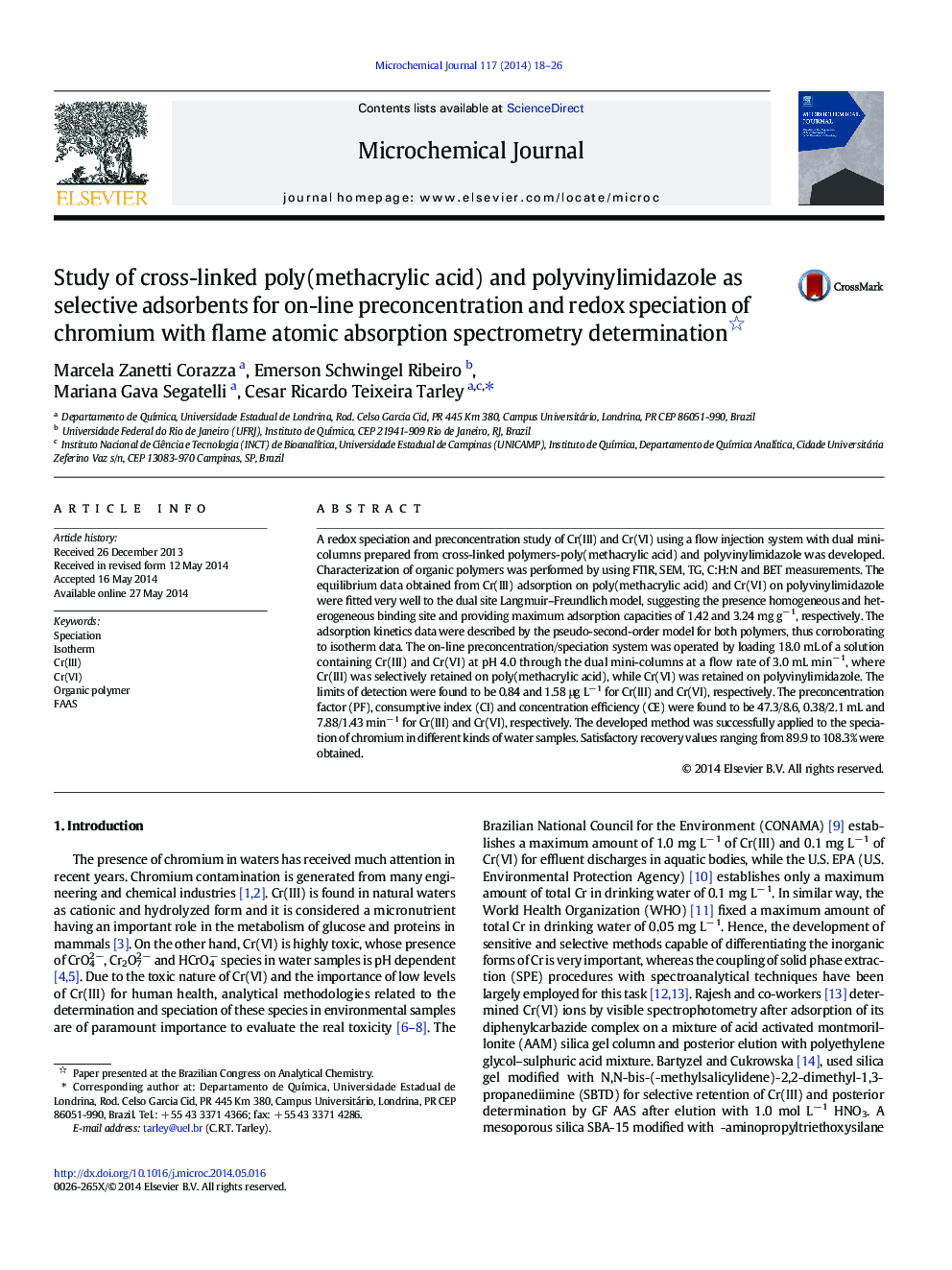| کد مقاله | کد نشریه | سال انتشار | مقاله انگلیسی | نسخه تمام متن |
|---|---|---|---|---|
| 7642686 | 1494877 | 2014 | 9 صفحه PDF | دانلود رایگان |
عنوان انگلیسی مقاله ISI
Study of cross-linked poly(methacrylic acid) and polyvinylimidazole as selective adsorbents for on-line preconcentration and redox speciation of chromium with flame atomic absorption spectrometry determination
ترجمه فارسی عنوان
بررسی پلی (متاکریلیک اسید) متقابل و پلی وینیلیمیدازول به عنوان جاذب های انتخابی برای پیش سازش مستقیم و کروم با استفاده از رسوب جذب اتمی شعله
دانلود مقاله + سفارش ترجمه
دانلود مقاله ISI انگلیسی
رایگان برای ایرانیان
کلمات کلیدی
موضوعات مرتبط
مهندسی و علوم پایه
شیمی
شیمی آنالیزی یا شیمی تجزیه
چکیده انگلیسی
A redox speciation and preconcentration study of Cr(III) and Cr(VI) using a flow injection system with dual mini-columns prepared from cross-linked polymers-poly(methacrylic acid) and polyvinylimidazole was developed. Characterization of organic polymers was performed by using FTIR, SEM, TG, C:H:N and BET measurements. The equilibrium data obtained from Cr(III) adsorption on poly(methacrylic acid) and Cr(VI) on polyvinylimidazole were fitted very well to the dual site Langmuir-Freundlich model, suggesting the presence homogeneous and heterogeneous binding site and providing maximum adsorption capacities of 1.42 and 3.24 mg gâ 1, respectively. The adsorption kinetics data were described by the pseudo-second-order model for both polymers, thus corroborating to isotherm data. The on-line preconcentration/speciation system was operated by loading 18.0 mL of a solution containing Cr(III) and Cr(VI) at pH 4.0 through the dual mini-columns at a flow rate of 3.0 mL minâ 1, where Cr(III) was selectively retained on poly(methacrylic acid), while Cr(VI) was retained on polyvinylimidazole. The limits of detection were found to be 0.84 and 1.58 μg Lâ 1 for Cr(III) and Cr(VI), respectively. The preconcentration factor (PF), consumptive index (CI) and concentration efficiency (CE) were found to be 47.3/8.6, 0.38/2.1 mL and 7.88/1.43 minâ 1 for Cr(III) and Cr(VI), respectively. The developed method was successfully applied to the speciation of chromium in different kinds of water samples. Satisfactory recovery values ranging from 89.9 to 108.3% were obtained.
ناشر
Database: Elsevier - ScienceDirect (ساینس دایرکت)
Journal: Microchemical Journal - Volume 117, November 2014, Pages 18-26
Journal: Microchemical Journal - Volume 117, November 2014, Pages 18-26
نویسندگان
Marcela Zanetti Corazza, Emerson Schwingel Ribeiro, Mariana Gava Segatelli, Cesar Ricardo Teixeira Tarley,
